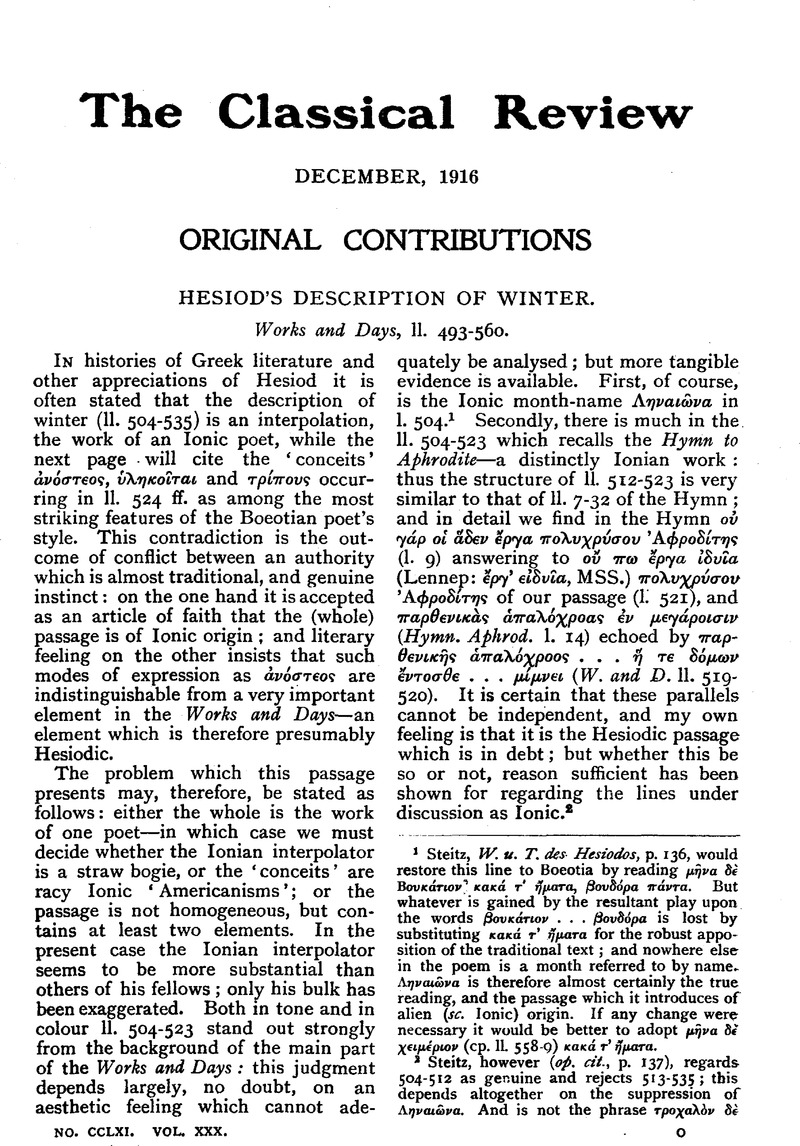No CrossRef data available.
Article contents
Hesiod's Description of Winter
Published online by Cambridge University Press: 27 October 2009
Abstract

- Type
- Original Contributions
- Information
- Copyright
- Copyright © The Classical Association 1916
References
page 209 note 1 Steitz, , W. u. T. des Hesiodos, p. 136Google Scholar, would restore this line to Boeotia by reading ![]() . But whatever is gained by the resultant play upon the words
. But whatever is gained by the resultant play upon the words ![]() is lost by substituting
is lost by substituting ![]() for the robust apposition of the traditional text; and nowhere else in the poem is a month referred to by name.
for the robust apposition of the traditional text; and nowhere else in the poem is a month referred to by name. ![]() is therefore almost certainly the true reading, and the passage which it introduces of alien (sc. Ionic) origin. If any change were necessary it would be better to adopt
is therefore almost certainly the true reading, and the passage which it introduces of alien (sc. Ionic) origin. If any change were necessary it would be better to adopt ![]() (cp. 11. 558–9)
(cp. 11. 558–9) ![]() .
.
page 209 note 2 Steitz, however (op. cit., p. 137), regards 504–512 as genuine and rejects 513–535; this depends altogether on the suppression of ![]() . And is not the phrase
. And is not the phrase ![]() (518) almost certainly by the same hand as
(518) almost certainly by the same hand as ![]() (504)? If so Steitz's distinction breaks down.
(504)? If so Steitz's distinction breaks down.
page 210 note 1 Hesiods Gedichte, p. 85.
page 210 note 2 The following list is complete, I think, for the Works and Days: ![]() (430),
(430), ![]() (524),
(524), ![]() (529),
(529), ![]() (533),
(533), ![]() (571),
(571), ![]() (605),
(605), ![]() (742),
(742), ![]() (778).
(778).
page 210 note 3 In frag. 96. 91 (R), from the Suitors of Helen, ![]() is formed in imitation of
is formed in imitation of ![]() , the whole line being cast in the mould of W. and D. 524.
, the whole line being cast in the mould of W. and D. 524.
page 210 note 4 ![]() (Hymn. Dem. 43; cf.
(Hymn. Dem. 43; cf. ![]() , Theag. 440) are formed on a totally different principle; while the ‘grinders’ and the ‘almond-tree’ of the famous passage, Ecclesiastes xii. Are allegorical in intention.
, Theag. 440) are formed on a totally different principle; while the ‘grinders’ and the ‘almond-tree’ of the famous passage, Ecclesiastes xii. Are allegorical in intention.
page 211 note 1 In 533 all MSS. Read ![]() ; Wachler's
; Wachler's ![]() (accepted by Rzach) is not supported by comparison with
(accepted by Rzach) is not supported by comparison with ![]()
page 211 note 2 This may be a device to help the memory.
page 211 note 3 Possibly taese are waggon-building and the like. One would be tempted to conjecture that 11. 455–7 have strayed from between 495 and 496; but if (as is probable) 455–7 are actually out of place, their proper position is between 426–7.
page 212 note 1 op. cit. p. 133.
page 212 note 2 The couplet, of course, may be only the beginning of a longer passage now lost.
page 213 note 1 Steitz (l.c.) suggests hutments for the serfs; but the need for these at mid-summer would not be pressing.
page 213 note 2 317 itself is a parody of p 347: ![]() .
.
page 213 note 3 LI. 559–560 are an abrupt change of subject, especially after the natural ending made by 11. 557–8. It is likely enough that they belong to the ‘first version.’




